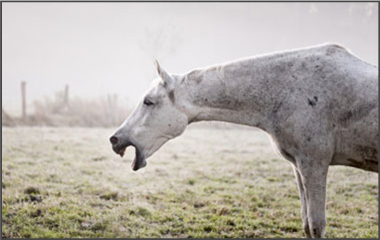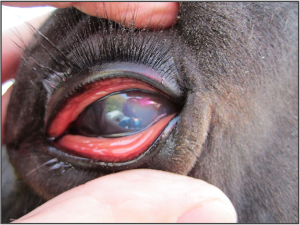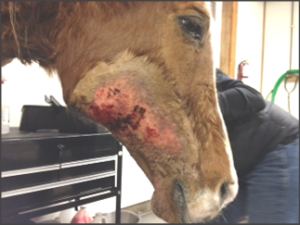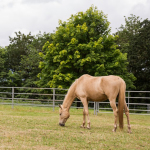Long dry summers bring about a number of challenges for horse owners and their veterinarians. Longer days and warmer dry weather is a blessing for horseback riding and outdoor events, but it also brings problems that can affect performance and in extreme cases can threaten their life.
The first concern most horse owners have is dehydration and water consumption. The average sized horse will consume at least 5-10 gallons of fresh water daily. Knowing your horse and their normal daily water consumption is essential to identify-ing a problem early before complications arise. Water is the number one nutrient and, although we often worry more about feed consumption than we do water, a horse without water will likely develop signs of severe colic within 2-3 days versus a horse without food.
Fresh grass is about 70% water, so horses grazing pastures usually receive a significant amount of their water requirement through grazing. Our sun burnt grass, however, has minimal water content. Monitor you horses’ water consumption and hydration status daily using mucous membrane color, moistness level, and capillary refill time (normal being pink, moist and less than 2 seconds). Pinching the skin of the neck and evaluating the time it takes to return to normal is an easy way to estimate hydration status with normal tented skin returning within 2 seconds. Checking for decreased urine output and drier or minimal manure production are also ways to detect dehydration and prevent colic. You should be concerned about a horse that appears lethargic with quiet eyes that appear sunken in, since this could be a sign of extreme dehydration. Always have plenty of fresh, clean, cool water available. You can also increase moisture in your horses’ diet by wetting down hay, making mashes and watering the pasture during times of greater concern.
With dry conditions also comes dust and with dust comes respiratory problems. We have seen an increased number of horses presenting with respiratory difficulty, coughing during exercise and grazing, or, in severe cases, increased respiratory effort, and exercise intolerance.
Whenever we see a horse coughing our first thought is infection, especially in our equine athletes who are frequently exposed to up-per respiratory viruses, in particular Equine Herpes Virus and Equine Influenza Virus. However, many others, particularly this summer have presented with allergic airway disease. Some individuals are more sensitive than others, and exposure to these allergens will cause inflammation of the respiratory tissues. Inflammation of the airways leads to thickening of the walls within the passages causing decreased airflow through the airways and increased effort, which in turn will cause constriction of the bronchi and other major airways.
Similar to a human with asthma, the more inflammation, and bronchoconstriction, the greater the effort needed to breathe. In severe cases, horse will develop permanent damage to the airways and chronic pulmonary disease as well as hypertrophy of the abdominal muscles to try to expel air out of the lungs leading to a “heave line” on their belly. Physical examination and diagnostic tests are used to rule out infectious causes. Environmental changes to decrease exposure to allergens and dust are very important to the successful control of allergic airway disease. Mild cases can be managed simply by dust control, proper ventilation, wetting down the hay and keeping clean stalls. More severe cases might require blood work, cultures and airway fluid samples to rule out more serious disease.
Treatment usually involves a combination of anti-inflammatories, antihistamines, bronchodilators, and corticoid steroids to decrease airway thickening and inflammation. Early treatment can control and help slow down progression of the condition that can not only be costly, but also severely affect performance and quality of life.
Third in line, but certainly not least, is fly and insect control. More than just a nuisance, flies can cause eye irritation, allergies, dermatitis and can spread disease. In the mildest of cases, fly irritation around the eyes will lead to conjunctivitis, sometimes recognized as pink eye, or can lead to a more severe trauma to the cornea and the surrounding eye structures.
Every horse is different and although some might experience just a mild localized discomfort associated with an insect bite, others will develop an immune system hypersensitivity reaction to insect saliva. These individuals will start by creating welts or local swellings, sometimes centered on a single bite and other times throughout the body. Repeated exposure can result in an insect hypersensitivity condition where the horse’s immune system is extremely sensitive resulting in self-mutilation, tail and mane rubbing and trauma to the abdomen where insect bites are common. This condition often requires aggressive insect control programs like fly predators, strong fly sprays, fly sheets and pasture management to eliminate sources of insect breeding grounds. When trauma or active inflammation is already present, most horses benefit from topical ointments to control and quiet inflammation as well as systemic anti-inflammatory medications, antihistamines or in severe cases, corticosteroids to control the immune reaction.
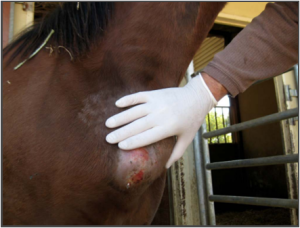
Pigeon Fever abscess
Biting insects and flies can also transfer disease. Usually associated warmer climates, insect related diseases like “Pigeon Fever” and “Summer Sores” have recently been causing problems in the Pacific Northwest. Most horse owners in the area heard about Pigeon Fever during our 2008 out-break. Pigeon Fever is a bacterial disease caused by Corynebacterium pseudotuberculosis and is believed to be transferred by flies and insects that introduce the bacteria into the horse while biting them. The bacterium settles in the lymph nodes mostly of the chest and ventrum of horses, including the sheath in geldings and the udder in mares.
When the bacterium multiplies, it creates large abscesses filled with thick, purulent discharge causing localized swelling. Most cases are not life threatening, but, if not treated appropriately, the bacteria settle within internal lymph nodes causing life-threatening abscesses in the liver, lungs and intestines. Pigeon fever is considered a cyclical disease with increased cases every 3-5 years. We have not seen the numbers that we saw in 2008 but due to the unusually warm summer and high number of insects, it warrants our constant monitoring and increased efforts towards fly control.
Another fly induced disease of horses is Summer Sores or Habronemiasis. This is a new problem in our area as well and we have encountered multiple cases in the last year. Summer Sores are spread by flies, that when feeding on wounds or mucous membranes release larvae of stomach worms that migrate into the tissues. Common areas for sores on the skin are around the lips, eye, and genitalia and present as inflamed, granulamatous lesions that will not heal and often contain hard, yellow sulfur granules that can be extracted from the wounds. The larva cause excessive inflammation and itchiness in the area, which lead to self-induced trauma and worsening of the lesions. These sores often require extensive debridement to remove the sulfur granules and aggressive treatment with anti-helmintics and anti-inflammatory medications.Although this list is not close to being all-encompassing, the idea is to plant a small seed of information of some of the things we worry about on these long, warm days.
